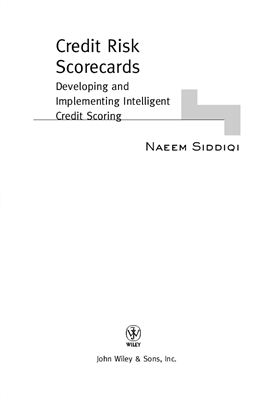John Wiley & Sons, Inc., 2005. - 210 pages.
This book presents a business-focused process for the development and implementation of risk prediction scorecards, one that builds upon a solid foundation of statistics and data mining principles. Statistical and data mining techniques and methodologies have been discussed in detail in various publications, and will not be covered in depth here. The key concepts that will be covered are:
The application of business intelligence to the scorecard development process, so that the development and implementation of scorecards is seen as an intelligent business solution to a business problem. Good scorecards are not built by passing data solely through a series of programs or algorithms—they are built when the data is passed through the analytical and business-trained mind of the user.
Collaborative scorecard development, in which end users, subject matter experts, implementers, modelers, and other stakeholders work in a cohesive and coherent manner to get better results.
The concept of building a risk profile—building scorecards that contain predictive variables representing major information categories. This mimics the thought processes of good risk adjudicators, who analyze information from credit applications, or customer behavior, and create a profile based on the different types of information available. They would not make a decision using four or five pieces of information only—so why should anyone build a scorecard that is narrow-based?
Anticipating impacts of decisions and preparing for them. Each decision made—whether on the definition of the target variable, segmentation, choice of variables, transformations, choice of cutoffs, or other strategies—starts a chain of events that impacts other areas of the company, as well as future performance. By tapping into corporate intelligence, and working in collaboration with others, the user will lea to anticipate the impact of each decision and prepare accordingly to minimize disruption and unpleasant surprises.
View of scorecards as decision support tools. Scorecards should be viewed as a tool to be used for better decision making, and should be created with this view. This means they must be understood and controlled; scorecard development should not result in a complex model that cannot be understood enough to make decisions or perform diagnostics.
This book presents a business-focused process for the development and implementation of risk prediction scorecards, one that builds upon a solid foundation of statistics and data mining principles. Statistical and data mining techniques and methodologies have been discussed in detail in various publications, and will not be covered in depth here. The key concepts that will be covered are:
The application of business intelligence to the scorecard development process, so that the development and implementation of scorecards is seen as an intelligent business solution to a business problem. Good scorecards are not built by passing data solely through a series of programs or algorithms—they are built when the data is passed through the analytical and business-trained mind of the user.
Collaborative scorecard development, in which end users, subject matter experts, implementers, modelers, and other stakeholders work in a cohesive and coherent manner to get better results.
The concept of building a risk profile—building scorecards that contain predictive variables representing major information categories. This mimics the thought processes of good risk adjudicators, who analyze information from credit applications, or customer behavior, and create a profile based on the different types of information available. They would not make a decision using four or five pieces of information only—so why should anyone build a scorecard that is narrow-based?
Anticipating impacts of decisions and preparing for them. Each decision made—whether on the definition of the target variable, segmentation, choice of variables, transformations, choice of cutoffs, or other strategies—starts a chain of events that impacts other areas of the company, as well as future performance. By tapping into corporate intelligence, and working in collaboration with others, the user will lea to anticipate the impact of each decision and prepare accordingly to minimize disruption and unpleasant surprises.
View of scorecards as decision support tools. Scorecards should be viewed as a tool to be used for better decision making, and should be created with this view. This means they must be understood and controlled; scorecard development should not result in a complex model that cannot be understood enough to make decisions or perform diagnostics.

